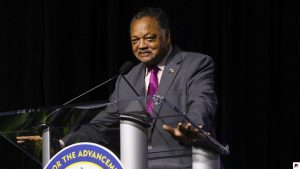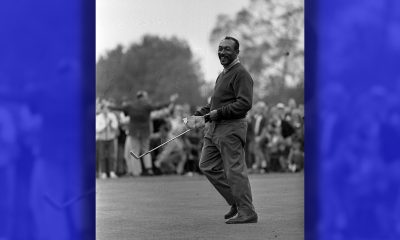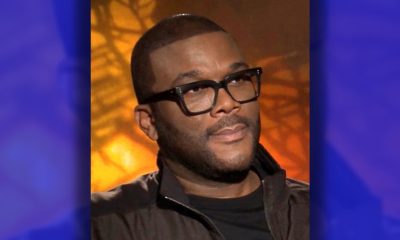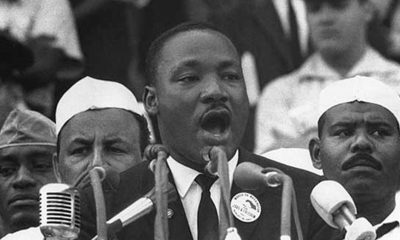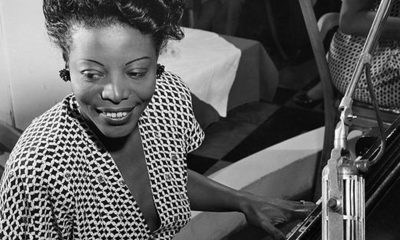Black History
First African-American Resident Physician at VUMC
THE TENNESSEE TRIBUNE — Harold Jordan, MD was the first African-American resident physician at Vanderbilt University Medical Center.
Dr. Harold Willoughby Jordan is the second grandson of Dr. John Henry Jordan and was born in the house in Newnan that John built. Harold was raised there in the shadow of his grandfather. He spent his childhood playing with John’s old medical bag, surrounded by his medical books and lasting legacy. From a young age, it was Harold’s desire to become a doctor, and he knew his parents expected it of him.
Harold was educated in Newnan and finished high school there before relocating to Atlanta to attend Morehouse College. He graduated from Morehouse with a bachelor’s degree in Biology in 1958 and then followed in his grandfather’s and great-grandfather’s footsteps by enrolling as a student at Meharry Medical College. Harold graduated in 1962 and completed one year of a residency in internal medicine before deciding to pursue psychiatry instead. He was the first black medical resident on record at Vanderbilt University.
After completing his education, Harold became a faculty member at Meharry Medical College and served as Chairman of the Department of Psychiatry for 18 years as well as Acting Dean of the School of Medicine. He was loyal to Meharry and only left in the 1970’s to serve as the first black Commissioner of Mental Health for the State of Tennessee. A state building, the Harold W. Jordan Habilitation Center, is named in his honor.
February 8, 2019 marked the launch of the newest of the named lectures in the Department of Psychiatry and Behavioral Sciences – the Dr. Harold Jordan Diversity and Inclusion Lecture.
Harold Jordan, MD was the first African-American resident physician at Vanderbilt University Medical Center, completing a general psychiatry residency between 1964 and 1967. Dr. Jordan’s history with the Department of Psychiatry and Vanderbilt University School of Medicine was outlined in the article “Hidden Figure” from the Summer 2017 issue of Vanderbilt Medicine Magazine.
Harold Jordan, M.D., has had a distinguished medical career that includes many highlights, including being chair of Psychiatry at Meharry Medical College, his medical alma mater, and serving as acting dean of the School of Medicine at Meharry as well.
Besides his academic career, Jordan was devoted to improving mental health care for the public through governmental service. He was Assistant Commissioner for Psychiatric Services and, following that, Commissioner of Mental Health and Mental Retardation for the state of Tennessee, and performed those jobs with such distinction that the state named a building in his honor on the campus of Clover Bottom Developmental Center, the state facility for people with severe intellectual disabilities which closed in 2016.
But a lesser-known part of Jordan’s professional life is his role as a pioneer at Vanderbilt University Medical Center (VUMC). In 1964 he became the first African-American resident physician at VUMC.
It’s fair to say that he began that groundbreaking achievement with little fanfare, and it’s fair to say that the achievement has received little fanfare since.
Reached at his home in California, where he moved after retirement, Jordan recalled interviewing with William F. Orr Jr., M.D., who was chair of Psychiatry at Vanderbilt from 1947 to 1969.
“Dr. Lloyd Elam arranged for me to meet Dr. Orr,” he said. With bemused understatement, and the hint of a chuckle, he added, “Obviously, that was very good for me.”
Elam, who later served as President of Meharry, was on the Psychiatry faculty at that institution and recommended that Jordan, who had already done an internship year at Meharry in Internal Medicine, consider a slot at Vanderbilt because, at the time, Meharry did not offer a residency in Psychiatry.
The interview went well, and Orr offered Jordan one of the three residency slots in Psychiatry that year.
But, Jordan recalls, Orr did more than offer him a position.
“Dr. Orr was very encouraging, accepting and protective,” Jordan said, clearly recalling a time when not all institutions exhibited those attitudes toward African-Americans. “He made it clear that I would be accepted. I felt secure. I knew the path was clear for me.”
Jordan’s family roots in medicine are deep; both his great-grandfather and grandfather were physicians who trained at Meharry. When he was growing up in Newnan, Georgia, just south of Atlanta, he heard family tales of his medical forbears and was inspired to follow their footsteps.
“I had wanted to do that since I heard about them,” he said.
Despite the low-key nature with which Jordan’s residency was handled, the groundbreaking nature of what was going on would have been known to all of the participants.
Vanderbilt’s first African-American student, Joseph Johnson Jr., was admitted to the Divinity School in 1953, and in 1956 two black law students had been admitted as well. But despite the presence of a few black students on campus, at that time there were no African-American residents at Vanderbilt Hospital, and it would be two more years, 1966, before the Vanderbilt School of Medicine would admit its first African-American student, Levi Watkins Jr.
“He paved the way for everyone who came after him,” Churchwell said. “To be an African-American resident in a sea of white residents at a Southern medical institution, I would call him a true Robinson Crusoe.”
Just as Vanderbilt was changing in that era, so was the country. As it happened, the day after Jordan began his residency at VUMC, July 1, 1964, President Lyndon Johnson signed the Civil Rights Act of 1964, mandating an end to discrimination in public accommodations.
Jordan says the faculty and his fellow residents were encouraging and supportive—“My colleagues were fine—there were no problems in Psychiatry”—but the unusual sight for that time of an African-American physician at Vanderbilt sometimes made for awkward misunderstandings.
“I walked into the Emergency Room [for a consult] and somebody thought I was the janitor and said, ‘The trash is over there,’” he remembered.
From across the decades of an honored career in medicine, Jordan, who turned 80 this year, says he has no ill feeling about such slights. “I would laugh at them, like, ‘What are you talking about?’” he said.
After his three years of residency at VUMC, Jordan pursued his academic career at Meharry and his public service career with the State of Tennessee, but also maintained a clinical appointment on the faculty of the Vanderbilt University School of Medicine until 2016.
In a 1971 letter in support of Jordan’s faculty appointment at Vanderbilt, Robert M. Reed, M.D., a Psychiatry faculty member of that era, wrote that, since Jordan was the first black resident to train at Vanderbilt, “his original appointment and subsequent performance were watched and monitored by a great many people as constituting something of a ‘test case.’”
He adds, “If indeed it were a test, then Harold passed it with honors, in my opinion.”
Andre Churchwell, M.D., Chief Diversity Officer for Vanderbilt University Medical Center, senior associate dean for Diversity Affairs, and Levi Watkins Jr. M.D. Chair, professor of Medicine, Biomedical Engineering and Radiology and Radiological Sciences, said that Jordan’s contributions to VUMC are important to remember.
“He paved the way for everyone who came after him,” Churchwell said. “To be an African-American resident in a sea of white residents at a Southern medical institution, I would call him a true Robinson Crusoe.”
A 1967 Psychiatry departmental group photo makes Churchwell’s point. It shows 40 or so people lined up around the traditional entrance to the School of Medicine, and Jordan is indeed the only African-American in a sea of white faces.
Given the varieties of reactions to Jordan’s presence and his role at the Medical Center in the mid-1960s, Churchwell added, “The fact that he was studying psychiatry probably helped him.”
For his part, Jordan says his time at Vanderbilt was important to him, both personally and professionally.
“It was a very positive influence,” he said. “I just felt very supported at both Meharry and Vanderbilt. I felt blessed to have had that experience in Psychiatry.”
He is married to Geraldine Crawford Jordan, a Meharry Medical College nursing school graduate. Thy have four children: Harold, Vincent, Karen and Kristi, as well as four grandchildren.
This article originally appeared in The Tennessee Tribune.
Activism
Oakland Post: Week of April 17 – 23, 2024
The printed Weekly Edition of the Oakland Post: Week of April 17 – 23, 2024

To enlarge your view of this issue, use the slider, magnifying glass icon or full page icon in the lower right corner of the browser window. ![]()
Black History
Matthew Henson: Explorer Extraordinaire
Matthew Henson, a trailblazing explorer who overcame countless obstacles to leave an incredible mark on history. Born on August 8, 1866, in Charles County, Maryland, his journey is a testament to the power of determination and the spirit of adventure.

By Tamara Shiloh
Matthew Henson, a trailblazing explorer who overcame countless obstacles to leave an incredible mark on history. Born on August 8, 1866, in Charles County, Maryland, his journey is a testament to the power of determination and the spirit of adventure.
Henson’s life began amidst the backdrop of post-Civil War America, where opportunities for African Americans were scarce. From a young age, he possessed an insatiable curiosity about the world beyond his small town. At the age of 12, he embarked on a journey that would change the course of his life forever when he joined a merchant ship as a cabin boy.
His most famous expedition was his journey to the Arctic with renowned explorer Robert E. Peary. In 1887, Henson joined Peary’s crew as a seaman and quickly proved himself to be invaluable with his skills as a navigator and craftsman. Over the course of several expeditions, Matthew endured extreme cold, treacherous terrain, and grueling conditions as he and Peary sought to reach the elusive North Pole.
In 1908–09, Peary set out on his eighth attempt to reach the North Pole. It was a big expedition, with Peary planning to leave supplies along the way. When he and Henson boarded their ship, the Roosevelt, leaving Greenland on August 18, 1909, they were joined by a large group. This included 22 Inuit men, 17 Inuit women, 10 children, 246 dogs, 70 tons of whale meat, blubber from 50 walruses, hunting gear, and tons of coal.
In February, Henson and Peary left their anchored ship at Ellesmere Island’s Cape Sheridan, along with the Inuit men and 130 dogs. They worked together to set up a trail and supplies along the way to the Pole.
Peary picked Henson and four Inuit people to join him in the final push to the Pole. However, before they reached their destination, Peary couldn’t walk anymore and had to ride in a dog sled. He sent Henson ahead to scout the way. In a later interview with a newspaper, Henson recalled being in the lead and realizing they had gone too far. The group turned back, and Henson noticed his footprints helped guide them to their destination. At that location, Henson planted the American flag.
Henson’s legacy extends far beyond his expeditions to the Arctic. He shattered racial barriers in the world of exploration and inspired countless individuals, regardless of race, to dream big and pursue their passions. In 1937, he was finally recognized for his achievements when he was inducted into The Explorers Club, an organization dedicated to promoting scientific exploration and field research.
Matthew Henson died in the Bronx, New York, on March 9, 1955, at the age of 88.
Art
Marin County: A Snapshot of California’s Black History Is on Display
The Marin County Office of Education, located at 1111 Las Gallinas Ave in San Rafael, will host the extraordinary exhibit, “The Legacy of Marin City: A California Black History Story (1942-1960),” from Feb. 1 to May 31, 2024. The interactive, historical, and immersive exhibit featuring memorabilia from Black shipyard workers who migrated from the South to the West Coast to work at the Marinship shipyard will provide an enriching experience for students and school staff. Community organizations will also be invited to tour the exhibit.

By Post Staff
The Marin County Office of Education, located at 1111 Las Gallinas Ave in San Rafael, will host the extraordinary exhibit, “The Legacy of Marin City: A California Black History Story (1942-1960),” from Feb. 1 to May 31, 2024.
The interactive, historical, and immersive exhibit featuring memorabilia from Black shipyard workers who migrated from the South to the West Coast to work at the Marinship shipyard will provide an enriching experience for students and school staff. Community organizations will also be invited to tour the exhibit.
All will have the opportunity to visit and be guided by its curator Felecia Gaston.
The exhibit will include photographs, articles and artifacts about the Black experience in Marin City from 1942 to 1960 from the Felecia Gaston Collection, the Anne T. Kent California Room Collection, The Ruth Marion and Pirkle Jones Collection, The Bancroft Library, and the Daniel Ruark Collection.
It also features contemporary original artwork by Chuck D of the Rock and Roll Hall of Fame group Public Enemy, clay sculptures by San Francisco-based artist Kaytea Petro, and art pieces made by Marin City youth in collaboration with Lynn Sondag, Associate Professor of Art at Dominican University of California.
The exhibit explores how Marin City residents endured housing inequities over the years and captures the history of plans to remove Black residents from the area after World War II. Throughout, it embodies the spirit of survival and endurance that emboldened the people who made Marin City home.
Felecia Gaston is the author of the commemorative book, ‘A Brand New Start…This is Home: The Story of World War II Marinship and the Legacy of Marin City.’ Thanks to the generous contribution of benefactors, a set of Felecia’s book will be placed in every public elementary, middle, and high school library in Marin.
In addition, educators and librarians at each school will have the opportunity to engage with Felecia in a review of best practices for utilizing the valuable primary sources within the book.
“Our goal is to provide students with the opportunity to learn from these significant and historical contributions to Marin County, California, and the United States,” said John Carroll, Marin County Superintendent of Schools.
“By engaging with Felecia’s book and then visiting the exhibit, students will be able to further connect their knowledge and gain a deeper understanding of this significant historical period,” Carroll continued.
Felecia Gaston adds, “The Marin County Office of Education’s decision to bring the Marin City Historical Traveling Exhibit and publication, ‘A Brand New Start…This is Home’ to young students is intentional and plays a substantial role in the educational world. It is imperative that our community knows the contributions of Marin City Black residents to Marin County. Our youth are best placed to lead this transformation.”
The Marin County Office of Education will host an Open House Reception of the exhibit’s debut on Feb. 1 from 4 p.m. – 6 p.m.. All school staff, educators, librarians, and community members are encouraged to attend to preview the exhibit and connect with Felecia Gaston. To contact Gaston, email MarinCityLegacy@marinschools.org
-

 Activism4 weeks ago
Activism4 weeks agoOakland Post: Week of March 20 – 26, 2024
-

 #NNPA BlackPress3 weeks ago
#NNPA BlackPress3 weeks agoCOMMENTARY: D.C. Crime Bill Fails to Address Root Causes of Violence and Incarceration
-

 #NNPA BlackPress3 weeks ago
#NNPA BlackPress3 weeks agoMayor, City Council President React to May 31 Closing of Birmingham-Southern College
-

 #NNPA BlackPress4 weeks ago
#NNPA BlackPress4 weeks agoCOMMENTARY: Lady Day and The Lights!
-

 #NNPA BlackPress3 weeks ago
#NNPA BlackPress3 weeks agoFrom Raids to Revelations: The Dark Turn in Sean ‘Diddy’ Combs’ Saga
-

 Activism3 weeks ago
Activism3 weeks agoOakland Post: Week of March 27 – April 2, 2024
-

 #NNPA BlackPress4 weeks ago
#NNPA BlackPress4 weeks agoBaltimore Key Bridge Catastrophe: A City’s Heartbreak and a Nation’s Alarm
-

 #NNPA BlackPress4 weeks ago
#NNPA BlackPress4 weeks agoBaltimore’s Key Bridge Struck by Ship, Collapses into Water

